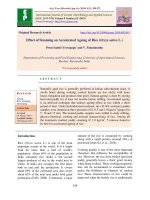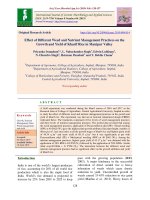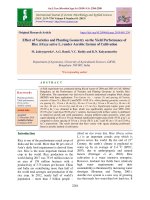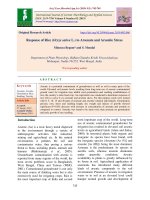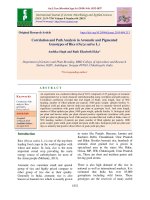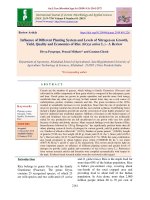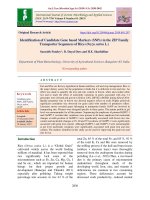Effect of tillage and nutrient management practices on yield and economics of rice (Oryza sativa) – Maize (Zea mays) cropping system in north Bihar
Bạn đang xem bản rút gọn của tài liệu. Xem và tải ngay bản đầy đủ của tài liệu tại đây (335.21 KB, 6 trang )
Int.J.Curr.Microbiol.App.Sci (2019) 8(3): 1365-1370
International Journal of Current Microbiology and Applied Sciences
ISSN: 2319-7706 Volume 8 Number 03 (2019)
Journal homepage:
Original Research Article
/>
Effect of Tillage and Nutrient Management Practices on Yield and
Economics of Rice (Oryza sativa) – Maize (Zea mays) Cropping
System in North Bihar
Mritunjay Kumar, B. Mahesh Naik*, M. Karthika, Navnit Kumar and A. Kumar
Department of Agronomy, TCA, Dholi-843121, India
*Corresponding author
ABSTRACT
Keywords
Conservation
tillage, Nutrient
management,
Permanent bed,
SSNM, MGEY
Article Info
Accepted:
12 February 2019
Available Online:
10 March 2019
In India rice-wheat cropping has been adopted widely which leads to deterioration of soil
fertility and decrease in water use efficiency. In addition to these change in climate,
vagaries of monsoon also leads to decrease in yields of the crop. Conservation agricultural
(CA) based management practices together with nutrient management have demonstrated
to produce more with less by these way it also conserve and sustain natural resources. In
north eastern India maize crop is grown alternative to rice based cropping system due to
variability in climatic condition and degradation of resources. Therefore, we attempted to
evaluate the rice maize cropping system under conservation agriculture. The experiment
was established in the year 2010 in Kharif season at Trihut College of Agriculture, Dholi,
India. It was laid out in split plot design. The treatments in the main plot were the
combination of tillage viz., zero tillage (ZT), conventional tillage (CT) and permanent bed
(PB) whereas, in subplot were the combination of nutrient management viz., RDF, SSNM
and FFP. However, rice is planted in kharif season and maize is sown in rabi season. After
7 years the results revealed that there was no significant difference in tillage treatment in
rice grain yield but ZT (51.5 q/ha) showed higher yields with compare to CT (51.0 q/ha)
and PB (49.3 q/ha). In Nutrient management FFP (52.7 q/ha) showed significantly higher
grain yield. However, rice stalk yield and Net returns was significantly superior in ZT and
FFP treatments. In maize, permanent bed and SSNM treatments showed significantly
superior grain yield (92.9 q/ha), stover yield (108.8 q/ha), net returns (Rs. 83457.9) and B:
C ratio (2.00). The maize equivalent yield (MEY) was significantly higher in permanent
bed (155.5 q/ha). Whereas, in nutrient management RDF (151.3 q/ha) and SSNM (151.3
q/ha) showed similar results over FFP (149.8 q/ha).
Introduction
In India, rice- wheat cropping system is the
most predominant cropping system which has
become largely mechanised, input intensive
and dependence on ground water. On the
other hand, rapidly rising demand for feed
and bio-fuel, declining availability of
irrigation water and adaptability of maize to
wide range of climate from temperate to
tropics has set a trend away from traditional
rice-rice and rice-wheat towards rice-maize
cropping system even though they are crucial
for country’s food security. Rice (Oryza
1365
Int.J.Curr.Microbiol.App.Sci (2019) 8(3): 1365-1370
sativa L.)- maize (Zea mays L.) cropping
system covers an area of about 0.53 mha in
India. Moreover, expanding value addition of
maize grains and the derived by-products will
give a scope for improving livelihood of the
farmers.
Conventional farming practices like intensive
tillage and improper nutrient management are
the reasons for the loss of soil fertility. This
leads to inefficient use of water and nutrients
leading to low productivity and input
efficiency posing threat to food and
environmental
security.
Nutrient
replenishment in soil balancing nutrient
extraction by crops is imperative to maintain
the soil fertility. In this way, conservation
agriculture is a new paradigm to achieve
sustainable
agricultural
production.
Conservation agriculture has proved to reduce
input costs, environmental pollution and
improve soil health (Jat et al., 2011). Proper
nutrient management of rice-maize exhaustive
system is mandate to reap rich harvests as
their productivity mainly depends on nutrient
management. Although the yield potential
depends on the genotype, it can be exploited
to maximum by their interaction with
management factors. Apparently, Site
Specific Nutrient Management System
(SSNM) equips us with an opportunity for
expertise management. It is a precision
technology aiming to optimize the supply of
soil nutrients to match the requirements of
crops. Therefore, a paradigm shift from
conventional to conservation tillage with
proper emphasis on nutrient management will
improve crop productivity, profitability and
sustainability. Keeping above points in view,
the present study was undertaken.
system. The experiment was conducted at
agronomical research farm, TCA Dholi, India.
It lies under latitude of 250 99’ N and
longitude of 850 60’ E and at 52.18 m at MSL
with annual rainfall 1145.8 mm. The mean
average maximum and minimum temperature
34.2oC and 7.1oCrespectively. The soil of the
experimental site was clay loam in texture,
calcareous (pH 8.2), high organic carbon
(0.80%).
Materials and Methods
The experiment was laid out in split plot
design with three replications at fixed site.
The total area of experiment site is 450 m2
and each unit is of 4.02x4.20 m2 size. The
treatments in the main plot were the
combination of tillage viz., zero tillage (ZT),
Conventional tillage (CT) and Permanent bed
(PB) and cropping system viz., rice in kharif
season and maize in rabi season. However,
the treatment in sub plot were the
combination of nutrient management viz.,
RDF (120-60–50 NPK kg/ha), SSNM (130–
75–45 NPK kg/ha) and FFP (160–75–60 NPK
kg/ha). In zero tillage, the rice seeds are
broadcasted uniformly throughout the plot in
kharif season, while in rabi season the maize
seeds were sown by opening the furrows after
hand plough without any preparatory tillage
operation. In case of permanent bed, the rice
seeds are sown in the furrows during kharif
however, in rabi the maize seeds are placed
on the ridges by making a small hole with
hand. In conventional tillage, the rice
seedlings are transplanted after 3-4 tillage
operations in puddled condition and line
sowing is done in maize during rabi. Residue
of every preceding crop was incorporated into
the soil in case of zero tillage and permanent
bed and reshaping of beds was done at the end
of every cropping cycle only in case of
permanent bed.
A Long-term tillage experiment was
established in the year 2010 under a set of
tillage, nutrient management and cropping
In rice and maize full dose of Pas diammonium phosphate (DAP) and K as
muriate of potash (MOP) and 1/3rd dose of N
1366
Int.J.Curr.Microbiol.App.Sci (2019) 8(3): 1365-1370
as urea (minus the N added as DAP) is
applied as basal dose. Remaining 2/3rd of N is
applied in 2 split doses (In case of maize two
equal split doses at knee high stage and before
tasseling stage when come to rice it is applied
at tillering stage and panicle initiation stage).
In the view, of best weed management
practice spraying of non-selective, systemic
herbicide like glyphosate @1.0 L a.i / ha in all
the plots of zero tillage and permanent bed 20
days before sowing to get good germination
of crops. In conventional tillage (CT)
application of pre-emergence herbicide at 2-3
days after sowing and in addition to it one
hand weeding is done at 30-35 days after
sowing. But in case of ZT and PB one hand
weeding is practicable for controlling
perennial weeds. At maturity, the crop was
harvested manually at the height of about
30cm above the ground level during
experimentation. The maize cobs were picked
manually and threshed by maize sheller to
estimate the grain yield. In case of rice,
panicle is threshed manually and grain yield is
noted. The moisture content present in the
grain were estimated by moisture meter and
grain moisture may be adjusted to 14%.
MGEY (kg/ha) is estimated as follows
MGEY (kg/ha) = economic yield of a crop
(kg / ha) x price (RS / kg) of same crop
Price (RS / kg) of maize
The net returns (NR) of each treatment
combination were calculated by deducting the
total cost (TC) of cultivation from gross
returns (GR) of respective treatments and the
benefit: cost ratio was calculated by dividing
the net returns with total cost of cultivation.
All the data recorded were analysed with the
help of analysis of variance (ANOVA)
technique (Gomez and Gomez, 1984) for split
– plot design using SAS 9.3 software (SAS
Institute, carry, NC). The least significant test
was to decipher the main and interaction
effects of treatments at 5% level of
significance (P<0.05).
Results and Discussion
The results from the experiment affirm that
both rice and maize crops showed variable
response to different tillage practices and
nutrient management. Among the various
tillage practices, maximum rice grain yield
was obtained from ZT (51.5 q/ha) but it was
not significantly superior over CT (51 q/ha)
and PB (49.3 q/ha). Maximum yield in ZT
may be attributed to more residue retention.
This causes an increase in soil organic carbon
status and leads better soil fertility. Similar
results were also reported by Jat et al., (2019)
wherein his experiment zero tillage direct
seeded rice (ZTDSR) showed superior grain
yield over permanent bed (PB) and
conventional tillage (CT). Whereas in maize,
PB (92.9 q/ha) gave significantly higher grain
yield over ZT (86.6 q/ha) and CT (80.5 q/ha).
This might have happened as it avoids the
effect of water logging on maize crop which
is being sensitive. Moreover, residue retention
will be done which results in increase of soil
fertility. Jat et al., (2013) also reported similar
results that permanent bed showed 8.2 -73.4%
increase in grain yield over CT and no-till flat
sowing. Other studies also reported higher
grain yield in PB with compare to other
treatments (Basavannepa et al., 2017).
However, nutrient management treatments,
FFP (52.7 q/ha) showed significantly superior
rice grain yield over 100% RDF (51.1 q/ha)
and SSNM (47.9 q/ha). Whereas, maize grain
yields were significantly superior in SSNM
(90.7 q/ha) over 100% RDF (86.5 q/ha) and
FFP (82.8 q/ha). This might be owing to fact
that right rate of application matching plant
requirements optimizing the nutrient use
thereby improving yields. Anand et al.,
(2017) reported significantly superior grain
yield in SSNM treatment over RDF. Kumar et
1367
Int.J.Curr.Microbiol.App.Sci (2019) 8(3): 1365-1370
al.(2015) and Pasuquin et al.,(2014) also
observed higher grain yield in SSNM
treatments with compare to other treatments.
Similar results were also obtained in straw
and stover yields. Harvest index is a function
of grain yield to total biological yield. So it
was also significantly influenced by various
tillage and nutrient management treatments in
maize cultivation. PB tillage practice and
SSNM treatment increased harvest index to
achieve a maximum of 34.7 and 35.2%
respectively.
Assessment of the data in terms of economic
traits is necessary for a technology to be
practically successful. The above work
revealed that ZT (62261.1₹/ha) gave
significantly higher monetary net returns than
PB (57573 ₹/ha) and CT (52885.4 ₹/ha) in
rice crop. This might be ascribed to more
yields in ZT system than PB and CT.
Additionally,
eliminating
tillage
also
increases the monetary returns. Similar results
were also reported by Jat et al., (2013),
Hassan et al.(2005). While in maize, PB
(83457.9₹/ha) gave significantly more net
returns than ZT (74992.8 ₹/ha) and CT
(66671.8 ₹/ha). More yields in permanent
bed gave more net returns. Other studies also
reported higher net returns in PB over other
treatments (Parihar et al., (2016) and Yadav et
al., (2015). Among different nutrient
management treatments, SSNM gave
maximum net returns than other treatments
viz., 100% RDF and FFP. Here, it may be
ascribed due to less fertilizer cost and more
nutrient use efficiency. This was on
agreement on with Shreenivas et al., (2017)
and Kumar et al.(2013).
Perusal of the data showed that among the
different tillage practices, higher benefit cost
ratio was recorded in PB (2.0). these is due to
Lower labour cost and mechanisation, lower
fertilizer application and more yield resulted
in high B: C ratio. These results were in
accordance with Jat et al., (2012). SSNM
treatment recorded that maximum benefit cost
ratio than other nutrient management
treatment. It improves overall profitability by
saving farmers money on fertilizer providing
greater returns on investment on fertilizers.
These results were on close proximity with
Shreenivas et al., (2017) and Kumar et al.,
(2013) (Table 1 and 2).
Table.1 Effect of tillage and nutrient management practices on yield and economics of rice crop
Treatments
Tillage practices
Zero Tillage (ZT)
Conventional tillage (CT)
Permanent Bed (PB)
SEm±
CD(P=0.05)
Nutrient management
100% RDF
SSNM
FFP
SEm±
CD(P=0.05)
Yield (q/ha)
Stalk yield (q/ha)
Net returns(₹/ha)
51.5
51.0
49.3
1.77
NS
66.2
60.1
62.6
2.16
4.54
62261.1
52885.4
57573.8
1542.80
6057.80
51.1
47.9
52.7
1.22
3.76
59.2
69
60.6
1.85
5.70
57058.2
62828
52834.1
1939.32
5975.64
1368
Int.J.Curr.Microbiol.App.Sci (2019) 8(3): 1365-1370
Table.2 Effect of tillage and nutrient management practices on yield and economics of maize crop
Treatments
Tillage practices
Zero Tillage (ZT)
Conventional tillage
(CT)
Permanent Bed (PB)
SEm±
CD(P=0.05)
Nutrient management
100% RDF
SSNM
FFP
SEm±
CD(P=0.05)
Yield
(q/ha)
Stover yield Harvest
(q/ha)
index (%)
Net
returns(₹/ha)
MEY
(q/ha)
B:C
ratio
86.6
80.5
100.9
93.9
34.7
33.8
74992.8
66671.8
151.6
145.3
1.8
1.6
92.9
2.13
8.35
108.8
2.47
9.70
35.4
0.19
0.75
83457.9
2880.65
11310.82
155.5
2.53
9.94
2
0.07
0.27
86.5
90.7
82.8
1.19
3.68
101.3
105.9
96.4
1.40
4.32
34.8
35.2
33.9
0.23
0.71
74799.5
80474.4
69848.6
1617.56
4984.20
151.3
151.3
149.8
1.86
5.73
1.8
1.9
1.7
0.04
0.12
Compilation of data revealed that system
productivity was significantly affected by
different treatments. MGEY was significantly
higher under permanent bed than zero tillage
and conventional tillage. This may be owed to
the reason that more maize grain yield in
permanent bed. Favourable soil moisture
conditions, residue addition and proper
establishment of maize crop in permanent bed
practice benefits higher yield. Furthermore,
maize being grown in rabi season provides it all
benign conditions. In nutrient management
practices although the SSNM produced
significantly produced higher grain yield,
MGEY was equal in both SSNM and 100%
RDF which was superior over FFP. SSNM
improves nutrient use efficiency of the crop
matching between supply and demand of
nutrients giving more yields.
In
conclusion,
conservation
agriculture
practices are based on minimum tillage,
maximum retention of crop residues and crop
rotation. By means of these principles, they
influence soil biological, chemical and physical
properties altering the nutrient dynamics of the
soil. By taking into account this nutrient
dynamics, SSNM based on targeted yield remits
maximum profits. Thus, SSNM in association
with conservation practise will be the best
practice to reap best harvests.
References
Anand, S. R., Vishwanatha, J. and Rajkumar, R.
H.
2017.
Site-specific
nutrient
management (SSNM) using “nutrient
expert” for hybrid maize (Zea mays L.)
under zero tillage in Thungabhadra
project (TBP) command area of
Karnataka. International Journal of
Current Microbiology and Applied
Science 6(8): 3597-3605.
Basavanneppa, M. A., Gaddi, M. A., Chittapur,
B. M. and Basavarajappa, R. 2017.
Yield maximization through resource
conservation technologies under maizechickpea cropping system in vertisols of
Tungabhadra command project area of
Karnataka. Research on Crops 18(2):
225.
Hassan, I., Baksha, K. and Maqbool, A. 2005.
Impact assessment of zero tillage
technology in rice-wheat system: a case
study from Pakistani Punjab. Electronic
Journal of Environmental, Agricultural
and Food Chemistry 4(6): 1132-1137.
Jat, M.L., Saharawat, Y.S. and Gupta, R. 2011.
1369
Int.J.Curr.Microbiol.App.Sci (2019) 8(3): 1365-1370
Conservation agriculture in cereal
systems of south Asia: nutrient
management perspectives. Karnataka
Journal of Agricultural Sciences, 24(1):
100-105.
Jat, R. M., Wani, S. P., Singh, P., Pathak, P.,
Srinivas, K., Kumar, U., Pavani, E. and
Velmurgan, R. 2012. Effect of
conservation agriculture on productivity
and economics of different cropping
systems under rainfed condition in the
semi-arid tropics.
3rd International
Agronomy congress, 3: 888-890.
Jat, M. L., Gathala, M. K., Saharawat, Y. S.,
Tetarwal, J. P., Gupta, R. and Singh, Y.
2013. Double no-till and permanent
raised beds in maize-wheat rotation of
north-western indo-gangetic plains of
India: Effects on crop yields, water
productivity, profitability and soil
physical properties. Field Crops
Research, 149: 291-299.
Jat, M.R., Singh, R.G., Kumar, M., Jat, M.L.,
Parihar, C.M., Bijarniya, D., Sutaliya,
J.M., Jat, M.K., Parihar, M.D.,
Kakraliya, S.K. and Gupta, R.K. 2019.
Ten years of conservation agriculture in
a rice-maize rotation of eastern gangetic
plains of India: yield trends, water
productivity and economic profitability.
Fields Crops Research, 232(2019): 1-10.
Kumar, R., Karmakar, S., Kumari, S., Sakar, A.
K., Dutta, S. K. and Majumdar, K.
2013. Improving productivity and
profitability of the maize-wheat system
in Jharkhand. Better crops, 97 (4): 2931.
Kumar, v., Singh, A. K., Jat, S. L., Parihar, C.
M., Pooniya, V., Singh, B. and Sharma,
S. 2015. Precision nutrient and
conservation agriculture practices for
enhancing productivity, profitability,
nutrient-use efficiencies and soil
nutrient status of maize (Zea mays)
hybrids. Indian Journal of Agricultural
sciences, 85 (7): 926-30.
Pasuquin, J. M., Pampolino, M. F., Witt, C.,
Dobermann, A. and Oberthur, T. 2014.
Closing
yield gaps in maize
production in southeast Asia through
Site-Specific Nutrient Management.
Field Crop Research, 156: 219-230.
Shreenivas, B. V., Ravi, M. V. and Latha, H. S.
2017. Effect of nutrient management
approaches on maximizing productivity,
nutrient uptake, soil fertility and
economics of maize-chickpea cropping
sequence. An Asian Journal of Soil
Science, 12 (1): 1-9.
Yadav, M. R., Parihar, C. M., Jat, S. L., Singh,
A. K., Kumar, D., Pooniya, V., Parihar,
M. D., Saveipune, D., Parmar, H. and
Jat, M. L. 2015. Effect of long-term and
diversified crop rotations on nutrient
uptake profitability and energetics of
maize (Zea mays L.) in north-western
India. Indian Journal of Agricultural
Sciences, 86(6): 743-9.
Yadav, M.R., Parihar, C.M., Jat, S.L., Singh,
A.K., Kumar, D., Pooniya, V., Parihar,
M.D., Saveipune, D., Parmar, H.and Jat,
M.L. 2016. Effect of long-term tillage
and diversified crop rotations on
nutrient uptake, profitability and
energetic of maize (Zea mays) in northwestern India. Indian Journal of
Agricultural Sciences, 86(6): 743-749.
How to cite this article:
Mritunjay Kumar, B. Mahesh Naik, M. Karthika, Navnit Kumar and A. Kumar. 2019. Effect of
Tillage and Nutrient Management Practices on Yield and Economics of Rice (Oryza sativa) –
Maize (Zea mays) Cropping System in North Bihar. Int.J.Curr.Microbiol.App.Sci. 8(03): 13651370. doi: />
1370

